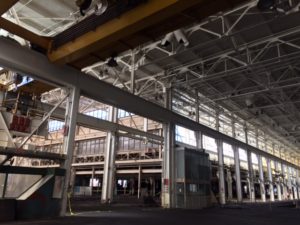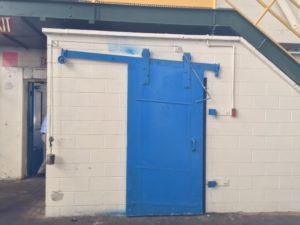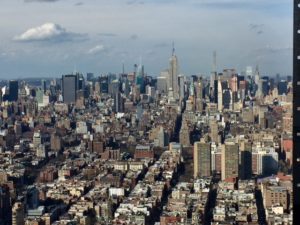
The former Niagara Machine & Tool Company complex at 683 Northland Avenue in Buffalo will be rehabilitated for mixed use including a Work Force Training Center. BAC/A+P is the preservation architect on the team.
It’s been five years since I launched Barbara A. Campagna/Architecture + Planning, PLLC and while many things have changed, my goal to work on “greening what’s already here” continues to be met, often in places I never expected. Many people are finding new ways to integrate historic preservation and green building practices, which makes my venture a delightful and intellectually inspiring one. This is blog THREE of my fifth anniversary week.
The past month has been a very good month for me and for my firm – with new important projects coming through the door and some permanence in my teaching position. As a result I have been able to reflect on how I plan to continue to integrate teaching with work – which for me are closely linked with research.
Greening What’s Already Here

One of the many gorgeous architectural details in the former Niagara Machine & Tool Company complex at 683 Northland Avenue in Buffalo will be rehabilitated for mixed use including a Work Force Training Center. BAC/A+P is the preservation architect on the team.
It is well established that the operations of buildings contribute almost 50% of all the greenhouse gas emissions in the United States — and making buildings more energy and resource efficient is one of the most immediate and measurable ways to address this growing concern. Since new and renovated high performing buildings, a growing number of which are LEED or green building rating certified, comprise less than 10% of the country’s portfolio, it is clear that the biggest and indeed the most important way to improve our impact on the planet is to improve the operations of our existing buildings
The green building world is in the midst of some major transitions. And that is saying a lot considering the past 10 years have seen nothing but transitions and transformations. The International Codes Council (ICC) has created a new green code, the International Green Construction Code (IGCC). LEED v4, the most comprehensive retooling that that groundbreaking rating system has seen in its fifteen years, was launched at Greenbuild last year. But we will not save the world just by building new LEED Platinum and net zero buildings. The only way we will save the world from climate disaster is by managing our buildings better, whether they are old or new.
With many new high performance approaches to improving the design and operations of our buildings and sites, we have started by referring back to our earliest passive features. The best traditional ways to modify our landscape and moderate our environment included responding to nature and acknowledging the regional climate. James Steele in Ecological Architecture: A Critical History reminds us that, “To set tradition and technology against each other is to establish a false dialectic. Instead, when do they overlap and how is this applied to environmental problems?”
There is a lot of talk about density and walkability in these new “green” times, and not all good. Edward Glaeser’s article in The Atlantic where he proclaims “all dense all the time,” arguing that urban development should be less restrained by policy; specifically, that redevelopment of low-density urban areas is necessary to supplying housing at pace with demand enough to keep housing prices affordable in the cities where people most want to live. Key features of cities such as historic districts and modern heritage are under threat by misplaced plans in the name of sustainability such as the Midcentury (un)Modern report( Midcentury (un)Modern_Terrapin Bright Green 2013e_1) recently prepared by Terrapin Bright Green which suggests that an entire era of building stock is disposable based on the evaluation of one office building in midtown Manhattan. Applying “inefficient” to an entire era of buildings can be dangerous. Hence the controversy over Michael Bloomberg’s Midtown East rezoning plan, which would have allowed New York to replace aging commercial buildings with office towers in East Midtown. The plan received derision for promoting density over neighborhood, new over old, and bigger buildings without transit or street improvements. What it also does is encourage demolition of existing buildings. But does one green approach, density, supersede another green approach — keeping what’s already here?
I can appreciate the importance density plays in cities like New York City, Chicago and San Francisco. But I do not think making every place a city like Dubai or even midtown Manhattan is what is good for our culture. It may from an intellectual viewpoint be good for the planet (maybe) but layering our density, our styles and the age of our buildings is what makes our lives and this planet interesting. It is up to us to figure out the balance. And it is this balance that I use to guide my research.
Conduct and share the research needed to transform the built environment toward sustainability.

Another evocative detail in the former Niagara Machine & Tool Company complex at 683 Northland Avenue in Buffalo will be rehabilitated for mixed use including a Work Force Training Center. BAC/A+P is the preservation architect on the team.
I believe that one of the key issues that we need to confront is how we handle our midcentury modern buildings, their systems, their materials and their urban impacts. Several years ago I organized a two-day symposium for thought leaders in the sustainability field and one of our speakers, a very powerful leader of a world-famous institution, presented his idea to save the world – “Starting tomorrow we should never build anything new ever again.” Theoretically that complements something I sometimes say, “The greenest world is one without us in it.” Many studies have now shown that over 50% of the greenhouse gas emissions in the US come from the operation and construction of buildings. And given the fact that 85% of our commercial building portfolio in the United States was built after 1945, the assumption can then easily be made that buildings from the modern era are the biggest problem we have from a climate change standpoint. Many would like you to think they are also the biggest problem we have in terms of aesthetics.
The true story is, of course, much more nuanced. Many modern buildings were built with experimental materials or approaches, which have not weathered well or worked as we thought they would – material-wise or conceptually. Many were built specifically to be disposable, but we now find ourselves dealing with them 50 years later. Despite all these facts, I LOVE modern buildings. I love the creativity and simplicity of many of them. I love the fact that our parents envisioned and created a brand new world. I love them because I see the possibilities and opportunities. Does it make sense to try to save them all? Of course not. Just like it does not make sense to try to save everything built before 1945.
Educate stakeholders in methods for transforming the built environment toward sustainability.

An industrial factory about to be rehabilitated to net zero. The former Niagara Machine & Tool Company complex at 683 Northland Avenue in Buffalo will be rehabilitated for mixed use including a Work Force Training Center. BAC/A+P is the preservation architect on the team.
By sharing research and its methodology, much needed data can be made available to users and leaders. Continuing work with past partners and stakeholders such as NCPTT, USGBC, Lawrence Berkeley Labs, Oak Ridge National Lab, and the EPA will be key to expanding my research agenda so that all can work together, ensuring that real changes and improvements could be made.
Improving our built environment by conducting research that provides us with the data we need to better design and operate our buildings will be crucial to all research entities. Designing a new building to LEED platinum does not indicate at ALL that the operation of that building will be any better than the building we replaced, because it is still maintained and operated by us. And we just cannot seem to operate our buildings to their design levels. The problem is not the buildings, it is us.
For decades we have been losing sound buildings and landmarks from “demolition by neglect” – owners not maintaining their buildings to the point of demolition, “they’re in such bad shape now, they need to be removed.” So, now we need to worry about owners claiming their new building will save the planet because it will be so much more energy efficient. Everyone seems to think the answer to green is black and white. But the answer is not in the broad-brush approach, it is in the nuance which is gray. And no one wants to hear that. Removing whole eras of buildings and their cultural story is not the answer. The answer is operating and retrofitting all of our buildings better. And that just needs good green research, something I look forward to continuing to do in both my professional and academic pursuits.
And if you’d like to “subscribe” or follow my blog, True Green Cities please sign up through the “Subscribe” button at the bottom left of this page. You’ll receive a daily recap when new blogs are posted. Or Sign up for the Feed.

